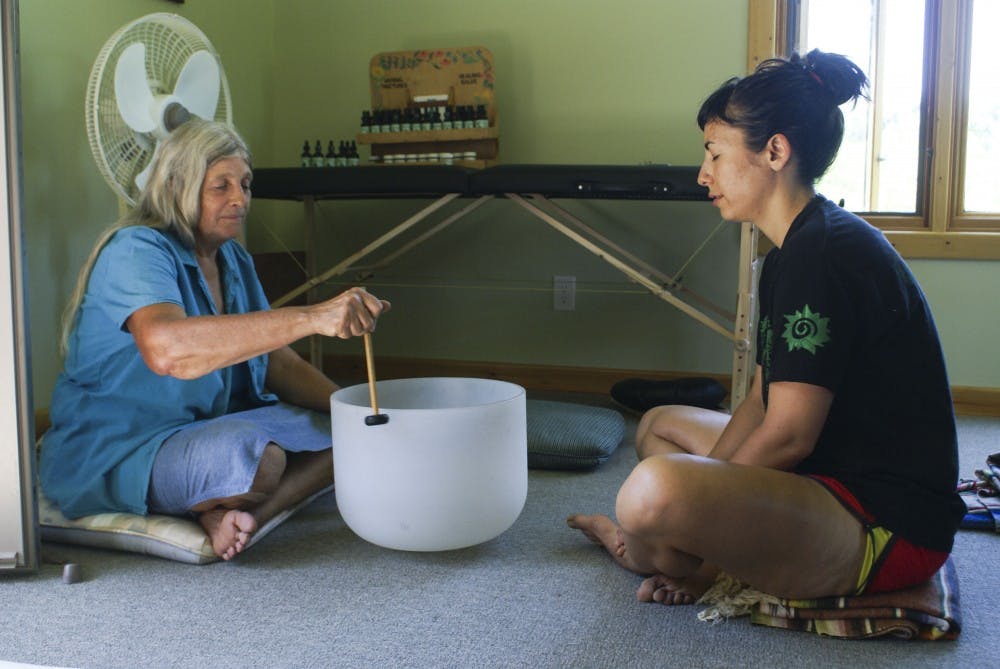Four gongs on each side of the large, 14-inch crystal bowl signaled the beginning of its song. What Susan Clearwater called “the singing bowl” rang out, its vibration moving in a circle from Clearwater to her intern Vida Chavez-Garcia, as they sat with their eyes closed and legs crossed, the bowl between them. Clearwater moved a stick in a circular motion around the outside of the bowl.
A large window took up the wall opposite them, showering half of their bodies in sunlight. The garden glowed outside.
“Ohm,” they said in unison, occasionally harmonizing.
This is how Clearwater and Chavez-Garcia start most of their mornings before they work on the gardens.
Past Lake Lemon and down a windy road, a gravel path leads to Clearwater’s five acres of land that she calls a sanctuary for plants and people. At Green Turtle Botanical Sanctuary in Nashville, Ind., she teaches classes on the healing nature of certain herbs, which she grows in the garden.
“The use of sound is one of the most ancient forms of healing,” Clearwater said.
After sound meditation, Clearwater slipped her shoes back on, sandal strap tan-lines crossing her bare feet.
**
Susan’s other intern, Brendan Patterson, ripped a plant out of the ground and examined its large, bulbous roots, which he would later clean and cut to a fine pulp.
In her classes, Clearwater teaches how to make tinctures — little vials of water, alcohol and various crushed roots used for medicinal purposes.
Clearwater picked a small leaf off the plant and lifted it to the sky.
Sunlight shined through the leaf, exposing its veins and turning it a lighter shade of green.
“See those black dots?” she said, pointing at the tiny dark circles on the leaf, only visible in the sunlight. “That’s how you identify St. John’s wort.”
St. John’s wort remedies kidney problems, alleviates nervous disorders and if made into a salve, helps mend wounds.
Like most healing herbs, its uses date back to ancient times. The ancient Greeks said it warded off evil, and medieval folklore said it had magical powers, but it gained its name from a Christian tale.
When St. John’s wort has matured, a yellow flower blooms, which appears not long after the apostle St. John’s birthday each year.
“That’s how you know if a plant is safe,” Clearwater said. “Look at the tradition of use.”
Clearwater also recommends this tincture to patients experiencing depression and anxiety. Many of her patients seek treatments for these conditions in lieu of taking anti-psychotic medicines such as Prozac.
People forget that pills are inspired by nature, Clearwater said.
“You put peppermint in your tea, and you’re consuming hundreds of chemicals,” she said. “Modern medicine is just isolating one chemical and synthetically reproducing it.”
The difference is, she said, Mother Nature knows how to weave all the chemicals together with the least amount of side effects. She calls Mother Nature the master chemist.
Using the backside of a hatchet, Clearwater hammered a spoke into the ground by her patch of echinacea plants. She was building a fence to protect the plants from the deer.
Whack, whack, whack.
Her long, silver hair whipped from the effort.
There’s more to healing than just swallowing a pill, she said.
**
Rain danced on the roof of Clearwater’s office at the Center for Wholism on North Walnut Street in Bloomington. The gray sky made the mint green color of the walls pop. Even the waiting room was adorned with colorful, whimsical artwork. Forms on the table had questions such as, “Are you a warm or cold person?”
Clearwater sees and treats patients at the Center for Wholism. The holistic approach tackles health problems by looking at the problem as a whole, exploring its causes and looking at a variety of remedies.
Plants bloomed next to diagrams of the human body. Pill bottles lined her cabinet, filled with different vitamins and minerals.
She said it is essential to examine both the patient’s psyche and lifestyle along with their need for certain vitamins or herbs.
This is especially true for common mental illnesses such as depression.
“Everything we think and feel has an effect on the body,” she said. “Thoughts and feelings create chemical reactions.”
Many physicians can be too quick to write prescriptions, Clearwater, a registered nurse, said. It’s just another quick fix of our culture.
“They overlook the holism of the body,” she said.
For anxiety and depression, she recommends certain vitamins and dietary changes but she also counsels.
“I try to find the root cause of the problem,” she said.
**
Chavez-Garcia crouched down next to a flower patch, pulling weeds.
She came from her farm in Argentina to learn from Clearwater so one day she can teach about medicinal plants. She works with Clearwater every day and lives on her property in a geometric dome Clearwater’s son built.
“I figured out when I’m closer to the plants, I’m happiest,” she said.
After going through a period of depression while living a fast-paced life in the city, Chavez-Garcia realized what she needed was nature in her life.
“It’s healing just being here,” she said.
Clearwater said she thinks depression and anxiety are, in part, caused by a deficiency in nature. The way people work nowadays, she said, staring at screens all day and not interacting with nature, it’s no wonder these mental illnesses are so common.
“I want to share this magic,” Chavez-Garcia said.
You can take the herbs, you can meditate and you can eat well, Clearwater said. But putting your hands in the dirt and caring for the earth is the complete treatment.
“The dirt is real,” Clearwater said. “It kind of connects us back to what’s real in our life.”






